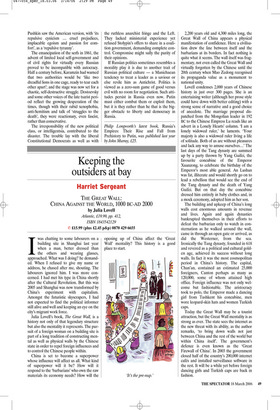Keeping the outsiders at bay
Harriet Sergeant
THE GREAT WALL: CHINA AGAINST THE WORLD, 1000 BC-AD 2000 by Julia Lovell Atlantic, £19.99, pp. 412, ISBN 1843542129 ✆ £15.99 (plus £2.45 p&p) 0870 429 6655 Iwas chatting to some labourers on a building site in Shanghai last year when a man, better dressed than the others and wearing glasses, approached. What was I doing? he demanded. When I refused to give my name or address, he chased after me, shouting. The labourers ignored him. I was more concerned. I had met his type in China shortly after the Cultural Revolution. But this was 2005 and Shanghai was now transformed by China’s experiment with capitalism. Amongst the futuristic skyscrapers, I had not expected to find the political informer still alive and well and keeping an eye on the city’s migrant work force.
Julia Lovell’s book, The Great Wall, is a history not only of that legendary structure but also the mentality it represents. The pursuit of a foreign woman on a building site is part of a long tradition of constructing mental as well as physical walls by the Chinese state in order to repel foreign influences and to control the Chinese people within.
China is set to become a superpower whose influence will affect us all. What kind of superpower will it be? How will it respond to the ‘barbarians’ who own the raw materials its economy needs? How will the opening up of China affect the ‘Great Wall’ mentality? This history is a good place to start. 2,200 years old and 4,300 miles long, the Great Wall of China appears a physical manifestation of confidence. Here a civilisation drew the line between itself and the barbarians at its borders. In fact nothing is quite what it seems. The wall itself was fragmentary, not even called the Great Wall and virtually forgotten by the Chinese until the 20th century when Mao Zedong recognised its propaganda value as a monument to national unity.
Lovell condenses 2,000 years of Chinese history in just over 300 pages. She is an entertaining writer (although her prose style could have down with better editing) with a strong sense of narrative and a good choice of anecdote. The marriage proposal dispatched from the Mongolian leader in 192 BC to the Chinese Empress Lu reads like an advert in a Lonely Hearts’ column. ‘I am a lonely widowed ruler,’ he laments. ‘Your majesty is also a widowed ruler living a life of solitude. Both of us are without pleasures and lack any way to amuse ourselves...’ The last days of the Tang dynasty are summed up by a party thrown by Yang Guifei, the favourite concubine of the Emperor Xuanzong, to celebrate the birthday of the Emperor’s most able general. An Lushan was fat, illiterate and would shortly go on to lead a rebellion that would see the end of the Tang dynasty and the death of Yang Guifei. But on that day the concubine dressed him entirely in baby clothes and, in a mock ceremony, adopted him as her son.
The building and upkeep of China’s long walls cost enormous amounts in revenue and lives. Again and again dynasties bankrupted themselves in their efforts to defeat the barbarian only to watch in consternation as he walked around the wall, came in through an open gate or arrived, as did the Westerner, from the sea. Ironically the Tang dynasty, founded in 618 and revered as a political and cultural golden age, achieved its success without long walls. In fact it was the most cosmopolitan period in China’s history. The capital, Chan’an, contained an estimated 25,000 foreigners, Canton perhaps as many as 120,000, some of whom attained high office. Foreign influence was not only welcome but fashionable. The aristocracy took to polo, the Emperor made a dancing girl from Tashkent his concubine, men wore leopard-skin hats and women Turkish caps.
Today the Great Wall may be a tourist attraction, but the Great Wall mentality is as strong as ever. The state sees the internet as the new threat with its ability, as the author remarks, ‘to bring down walls not just between China and the rest of the world but within China itself’. The government’s defence is even known as the ‘Great Firewall of China’. In 2003 the government closed half of the country’s 200,000 internet cafés and installed surveillance software in the rest. It will be a while yet before foreign dancing girls and Turkish caps are back in fashion.


















































































 Previous page
Previous page